A high percentage on-time delivery metric doesn't just reflect how well your business is performing in supply chain efficiency. It also plays a major role in customer retention.
On-time delivery (OTD) is a key performance metric that measures whether an organization is meeting its delivery goals. Consistently high performance in OTD is essential for maintaining a positive brand reputation and increasing customer satisfaction.
But many companies struggle to maintain a high on-time delivery rate, especially as delivery volumes continue to expand at such an unprecedented rate. Late or missed deliveries lead to frustrated customers and delays in lead times for other orders.
This article will explore the challenges companies face in achieving a high on-time delivery metric. We'll also provide actionable strategies for improving your metric, so you can increase customer retention and drive business success.
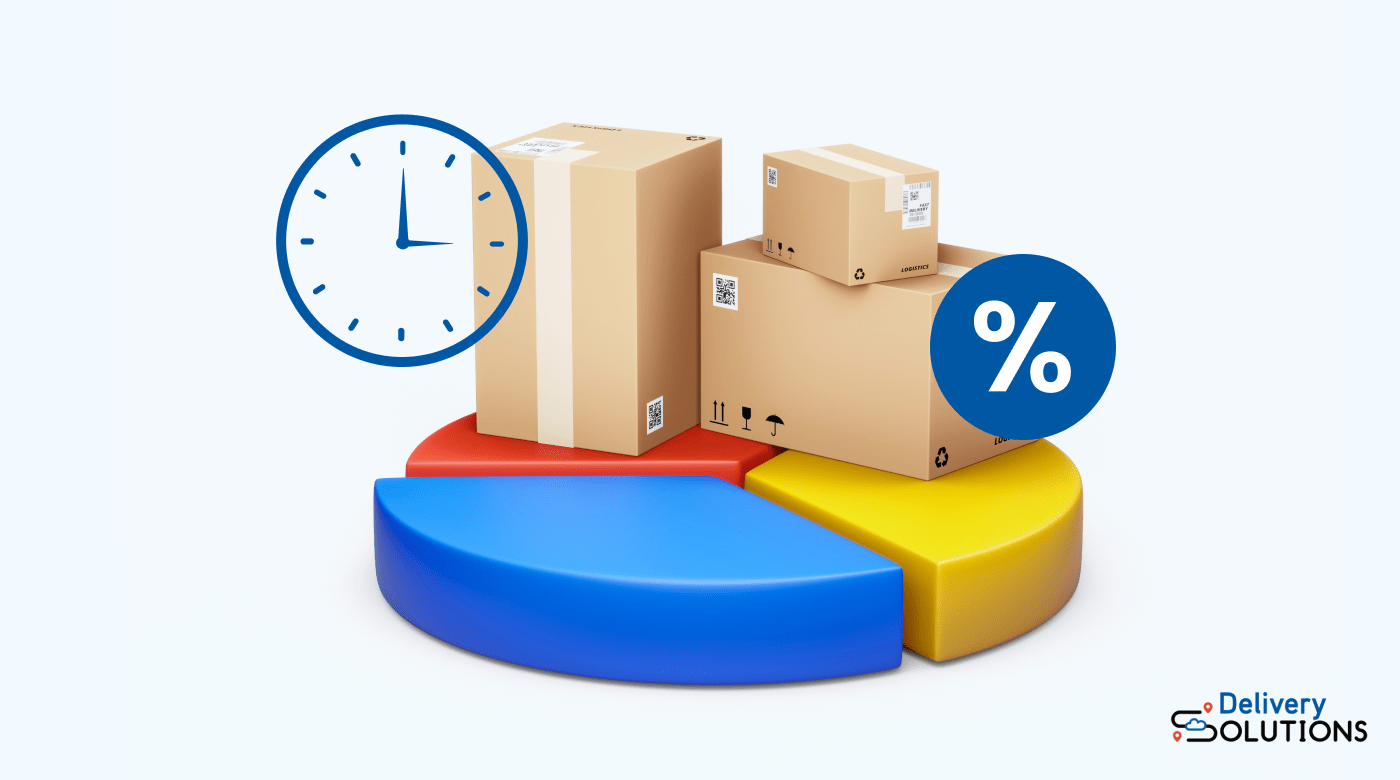
What is the on-time delivery metric (OTD)?
Put simply, the on-time delivery metric is the measurement of your company's ability to deliver goods or services on-time. It also provides a broader view of a company's efficiency. A business that consistently achieves high on-time delivery rates shows they have a well-organized and efficient supply chain and delivery system.
OTD is useful for monitoring performance and identifying areas for improvement. It can help you identify potential bottlenecks in your supply chain or logistical operations that may be causing delivery delays. And by tracking OTD over time, you can assess the effectiveness of your efforts to improve delivery performance, and make adjustments as needed.
Why is your on-time delivery metric so important?
With ever-increasing market competition, delivery times play a significant role in determining whether customers choose to do business with you. Customers want fast delivery and their expectations are at an all-time high. As many as 21% of consumers say that just one day past the expected delivery date would be unacceptable, and 27% hope to receive their purchase the same day or within the next day. Delivery is a big deal for consumers, so much so that 57% would go elsewhere if delivery times didn't meet their expectations.
On-time delivery and customer satisfaction
Failure to meet delivery deadlines may be due to a lack of resources such as sufficient staff or transportation infrastructure, inefficient processes, or supply chain disruptions. But whatever the cause, the impact of low OTD metrics on customer satisfaction can be significant.
Late deliveries cause frustration and inconvenience for customers, and 70% of shoppers say they'd be unhappy if their order didn't arrive on-time. Besides choosing to shop elsewhere, dissatisfied customers may leave negative online reviews, which can spread quickly on social media and other platforms. This can lead to a chain of unwelcome effects which reflect badly on your business's hard-won reputation. Customer trust and loyalty suffer as a result, and potential customers will inevitably be lost.
Handling a greater volume of complaints and providing compensation to dissatisfied customers, also leads to increased costs. In fact, 29% of customers would expect a discount or a refund for late delivery.
Clearly, there's a need to maintain a high on-time delivery metric if you want to keep customers satisfied and maintain a competitive edge. And yet, despite the importance of timely delivery in maintaining customer satisfaction and loyalty, many businesses struggle to maintain a high metric. As many as 76% of consumers reported at least one late delivery in the past year.
So we've established that maintaining a high on-time delivery metric is a crucial factor for customer satisfaction, keeping costs down and maintaining a competitive edge. But exactly how do you go about it?
As with anything else you want to improve, the first step is to accurately measure your current performance.
How to track your on-time delivery metric
How do you measure OTD?
The only two criteria you'll need to calculate your OTD are the total number of orders within a given time, and the total number of those delivered on-time. But to know how many orders have been delivered on-time, you'll have to decide exactly what you mean by 'on-time.'
First, decide how specific you intend the delivery date to be, and how specific the customer understands it to be. For example, consider whether a delivery will be considered late if it isn't received on the exact delivery date, or if a less precise delivery window has been agreed between you and the customer.
Also, when calculating on-time delivery, it makes more sense to consider things from the customer's point of view. For instance, if a customer orders 40 items and receives 36 on-time, you may be tempted to consider the order fulfilled for the purposes of calculating your metric. But it's more than likely that your customer won't consider the order fulfilled until all their items have been received. Ultimately, using the customer's experience and levels of satisfaction is a more accurate and meaningful way to measure your on-time delivery metric.
On-time delivery calculation
To calculate your on-time delivery metric, divide the total number of orders which were delivered on-time by the total number of orders. Times this by 100 to get a percentage figure.
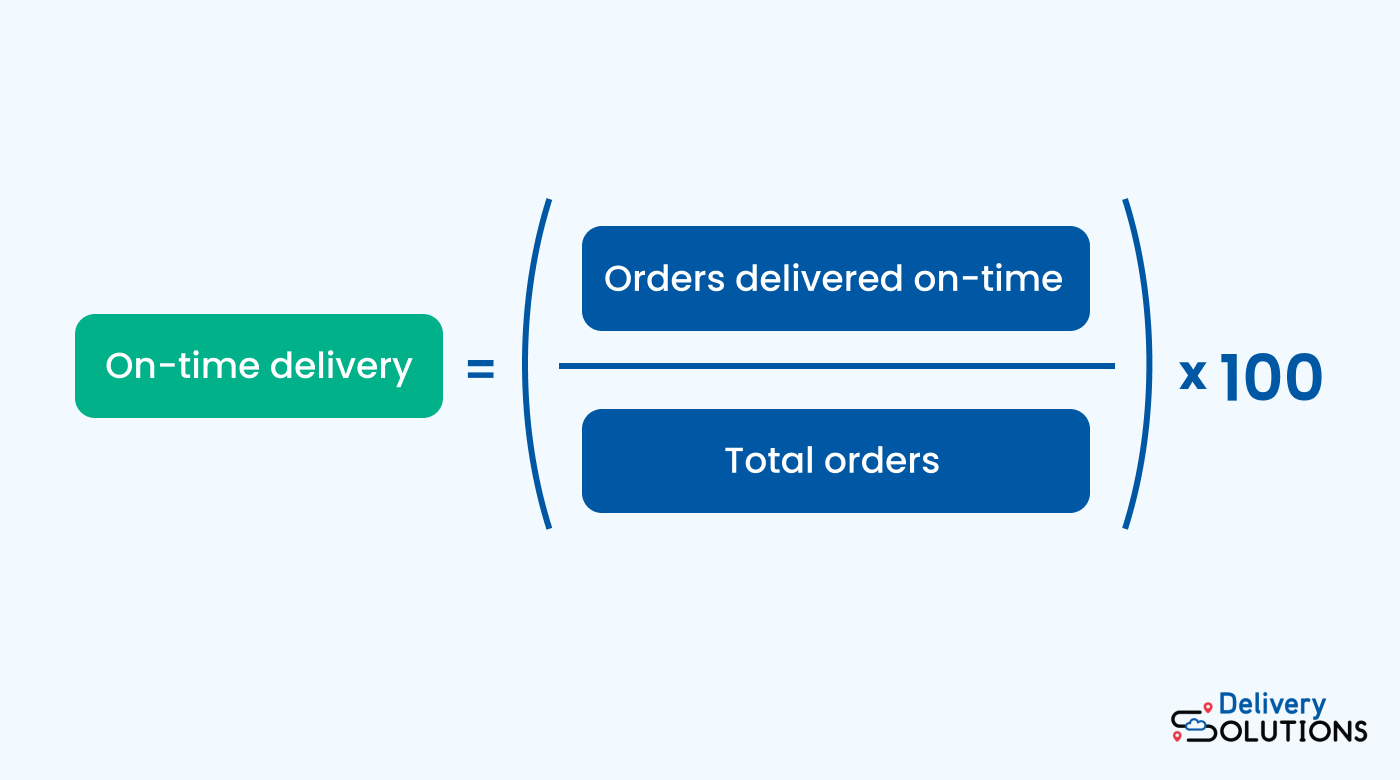
What other KPIs should you measure?
So now you know how to make a basic calculation of your on-time delivery metric. This is a great start, but maybe you'll want to dig even deeper. Other KPIs which can give additional insight into your performance and help you figure out exactly where problems might lie are:
- Order cycle time: The time it takes from when an order is placed until it's shipped.
- Inventory accuracy: The percentage of times the inventory matches what's recorded in the system.
- Order accuracy: The percentage of orders that are shipped correctly.
- Transit time: The time it takes for the product to travel from the point of origin to the destination.
- Lead time: The time it takes from order placement to delivery.
- Delivery time: The time it takes for the product or service to be delivered to the customer after it's been shipped or picked up from the seller.
- Fill rate: The percentage of the order that's delivered complete on the first shipment.
- Preparation of order time: The time it takes to process and prepare the order for shipment.
- Time at destination: The time the product spends at the destination location before being delivered to the customer.
- Time taken to return to base: The time it takes for the delivery vehicle or carrier to return to the starting location after completing a delivery.
- Shipping method: The chosen mode of transportation for delivering the product to the customer.
What can cause your on-time delivery metric to drop?
Maintaining a high on-time delivery metric can be extremely challenging for retailers, and 38% feel pressured by customer expectations for fast delivery. So let’s look at some of the issues that cause shipping delays and lead to problems in meeting these expectations.
Inventory management problems
Poor inventory management can lead to inaccurate information about stock levels, with ensuing problems and delays in fulfilling orders. Take a deep look at your inventory management and step up your processes to overcome this problem.
Problems with order fulfillment
Errors in order processing can result in delays or even canceled orders. Training staff and implementing automated order processing systems can reduce the likelihood of these errors.
Issues with the supply chain
Disruptions in the supply chain can cause delays in delivery. By improving communication and collaboration with suppliers and logistics partners, common supply chain issues such as delayed or lost shipments can be alleviated.
Last-mile delivery problems
Issues in the last mile of the delivery process, such as traffic congestion, weather conditions, or incorrect routing, can cause delays in order delivery. Last-mile delivery is the most challenging and expensive part of the supply chain. In fact, up to 55% of supply chain cost occurs in the last mile. So investing in last-mile delivery technology, such as real-time tracking and route optimization tools, can help to streamline this challenging stage, reduce delivery times, and save on costs, too.
Lack of visibility
Without real-time visibility into the delivery process, you may not be aware of delays or issues affecting delivery times. Delivery tracking and visibility tools can help you track the delivery process in real time, and address these issues as they arise.
Vehicle and driver issues
Delivery vehicles and drivers are critical to the delivery process. Problems with vehicles, such as breakdowns or accidents, or issues with drivers, such as illness or scheduling conflicts, can cause delays. Having backup drivers and maintaining a fleet of well-maintained vehicles can help to reduce the likelihood of these problems.
Rejected goods
Goods that are rejected by customers due to quality issues or incorrect order fulfillment can result in delays and additional costs for your business. Improving quality control processes and providing training to staff can help to reduce the likelihood of rejected goods.
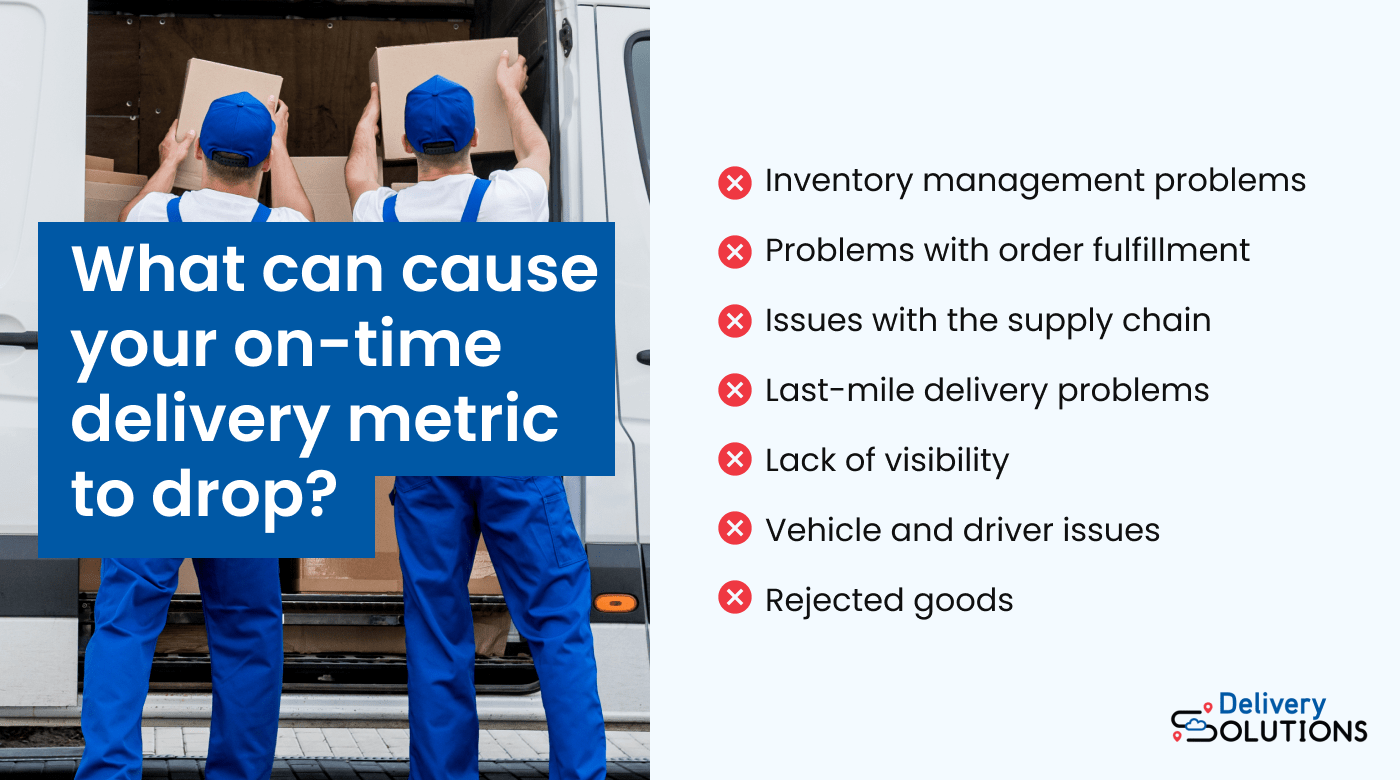
How to improve your on-time delivery KPI
Measure current performance
Measuring current performance will provide a baseline to identify areas for improvement. Measure your OTD as a baseline, and measure other key metrics too, to give you a deeper insight into where processes can be improved.
Identify and address problems and bottlenecks
Analyzing data and tracking performance metrics should identify any problems within your systems, and technology such as delivery management software can help substantially in this process.
An often overlooked source of useful information to identify where problems lie, are the people who work on the ground. Interviewing employees who are involved in the delivery process can provide valuable insights into the problems and bottlenecks that affect on-time delivery.
Set benchmarks
Setting benchmarks for on-time delivery performance will provide you with clear targets for improvement. These benchmarks should be realistic, achievable, and based on industry standards.
Adjust processes
Finally, armed with all the information you've gathered from the previous steps, you can adjust your processes to streamline and improve your delivery times. The steps you take will of course depend on the problems you've identified, but here's a few ways you may be able to make improvements:
- Streamline order picking: Improving the order-picking process reduces the time it takes to prepare orders for delivery.
- Minimize packaging: This can speed up the delivery process by reducing the time and effort required to pack orders, making packages smaller and lighter, and optimizing using delivery vehicles.
- Manage customer expectations: 97.8% of shoppers feel it's important to know when their packages will arrive. 94% want to be updated and informed about their delivery without having to ask. Regular updates and tracking can help manage their expectations and is also likely to reduce the number of missed deliveries.
- Have driver and vehicle backups: Prepare for unexpected events such as vehicle breakdown or driver sickness by having backups.
- Improve last-mile visibility: Providing real-time visibility into the delivery process can help to identify and address issues that may be affecting your On-Time delivery metric.
- Automate and connect your systems: This can help to reduce errors and delays in the delivery process.
- Increase overall visibility and efficiency using delivery management software.
- Staff training: Improve delivery times by enhancing staff skills and knowledge, thereby reducing errors, and improving efficiency.
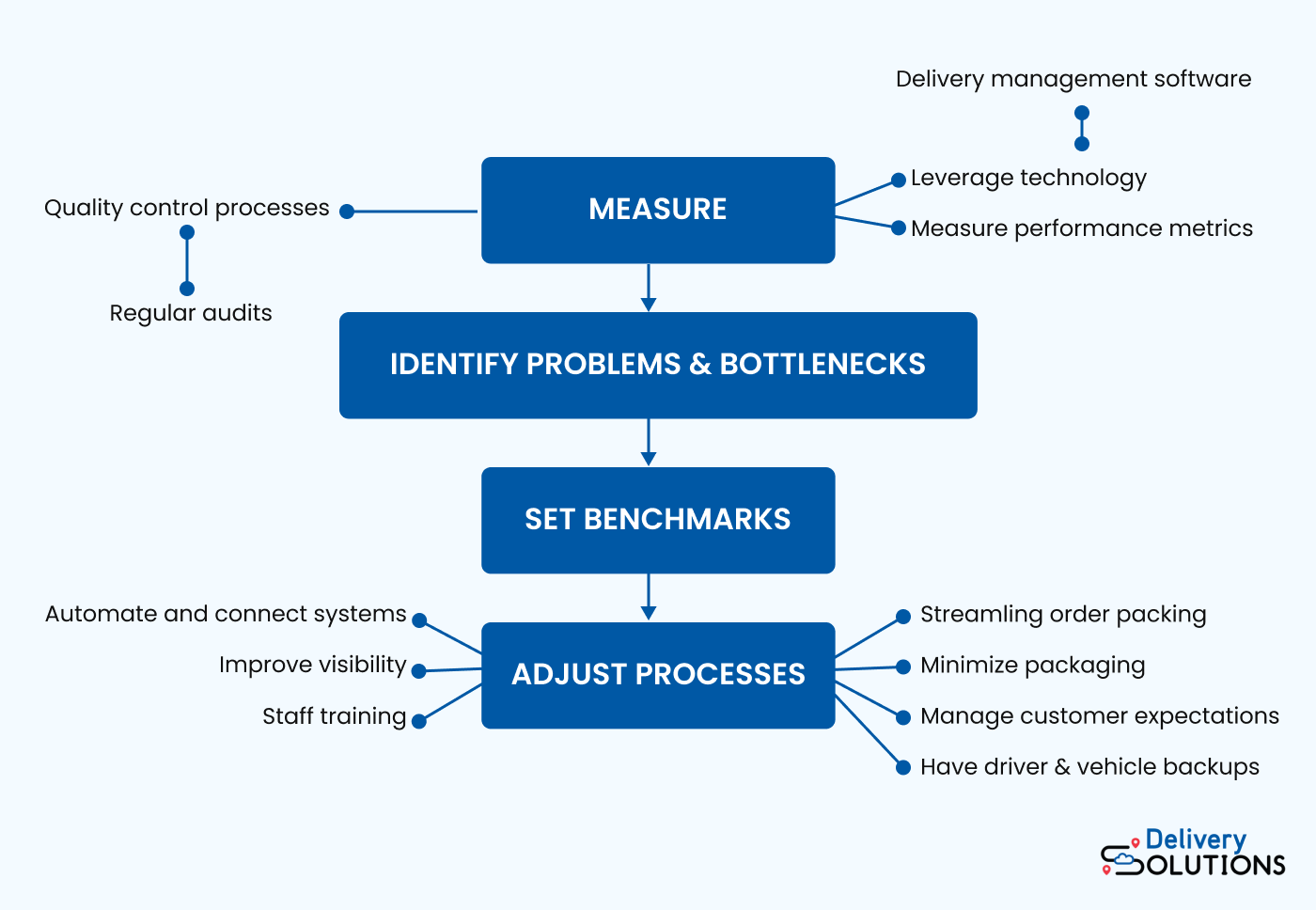
Leverage technology to improve your on-time delivery metric
Leveraging technology can be a game-changer when you're looking to improve your on-time delivery metrics. An omnichannel experience platform like Delivery Solutions can provide you with real-time visibility into your delivery processes, allowing you to track and address issues as they arise.
A range of features such as real-time tracking and optimization tools allow you to track delivery progress and make adjustments to routes and schedules as needed. Real-time alerts and notifications enable you to quickly respond to delays or other issues that may affect delivery times.
The ability to track packages is also important to customers. 91% of consumers actively track their packages, some multiple times a day. So by providing customers with the facility to track the progress of their package, they're more likely to feel happy with your service. They'll also be less likely to miss a delivery, which will have a positive effect on your on-time delivery metric.
Additionally, such technology can provide robust reporting and analytics capabilities, allowing your business to track key metrics such as delivery times and delivery volumes. By using these metrics to identify areas for improvement, you can take steps to optimize your delivery processes.
Sephora partners with Delivery Solutions
In 2021, Delivery Solutions teamed up with the leading beauty retailer Sephora. Since implementing Delivery Solution's software, Sephora have been able to provide their customers in the US and Canada with same-day delivery. Sephora chose Delivery Solutions over other platforms because of their expertise in this area and their ability to help them stay ahead of the competition. It also allows them to track and improve their OTD metric. Delivery Solutions' platform integrates smoothly with Sephora's existing e-commerce system. It helps the retailer save money, reduce technical problems and gain an even bigger competitive edge.
Conclusion
The on-time delivery metric is a holistic measure of the efficiency of your business systems. A high percentage metric demonstrates a well-organized supply chain and delivery system. Most importantly, improving and maintaining your OTD will help to keep your customers happy and your costs low.
Some of the factors that are difficult to control and which negatively affect OTD can be overcome with technology designed to streamline your delivery processes.
Delivery Solutions' platform manages retailer fulfillment processes with advanced features to improve efficiency and consistency at scale. To find out how Delivery Solutions can help your business achieve a high on-time delivery metric, schedule a free demo today.
Ryan Caldarone
Ryan is a Sr. Digital Marketing Manager with over ten years of experience in B2B eCommerce, specializing in brand storytelling and content. Having contributed to hundreds of creative projects for SMBs and startups across the tech, energy, and fine arts sectors, Ryan brings diverse perspectives.
Topics from this blog: Delivery On-time Improvement

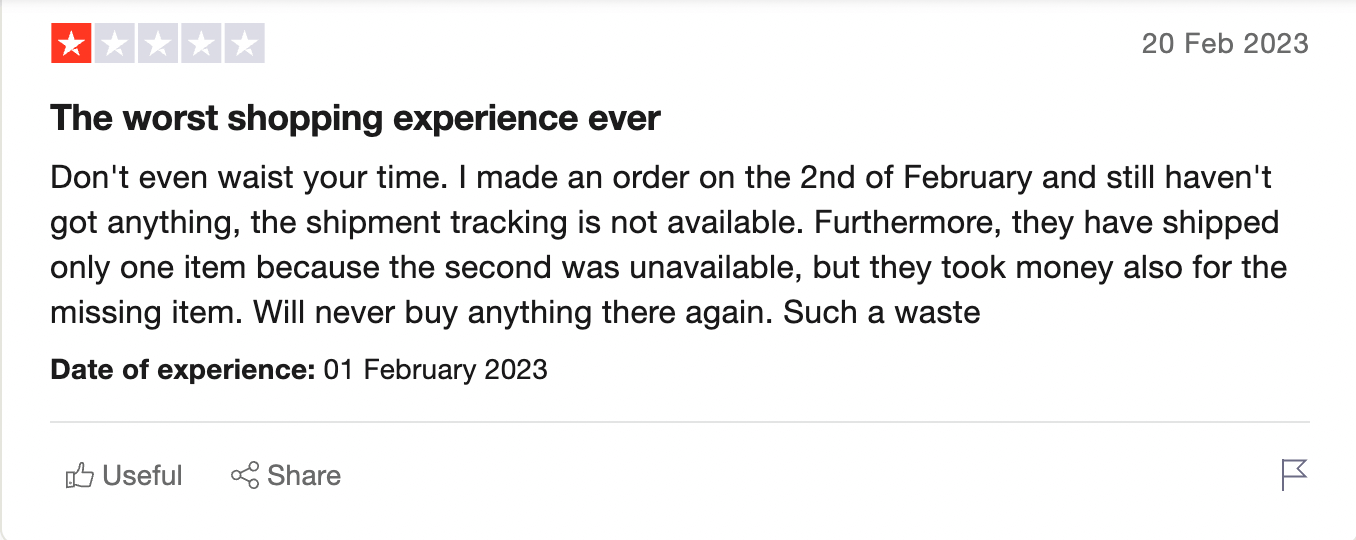 (
( (
( (
( (
(